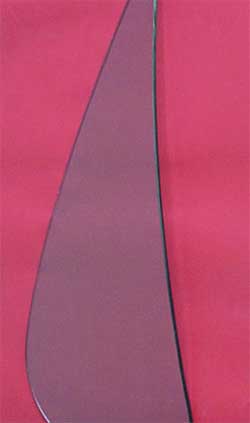| Posted: April 3, 2007 |
Gleaming prospects |
|
(Nanowerk News) Scratch-resistant spectacle lenses and displays, stainless-steel kitchen units without any fingerprints, antireflective glass on the instrument panels of cars and motorcycles – researchers from six institutes have been collaborating for three years in the Fraunhofer Network for Transparent Scratch Protection to develop new classes of materials. The scientists will be using a motorcycle as a demonstration platform for their development work, on show in Hall 6, Stand C02 of the Hannover Messe from April 16 to 20.
|
|
Bikers often get a rough deal: Their helmet visor clouds over in the rain, making it impossible to ride safely, while the instrument covers are exposed to the wind and weather, reflect the light, and easily get scratched. Help is now at hand from the Fraunhofer Network for Transparent Scratch Protection. At the Hannover Messe, the Network will be using the example of a motorcycle to demonstrate the wide range of applications for their new coating techniques. The speedometer cover, for example, is particularly scratch-resistant and also has an antireflective coating. Another topic of interest are tribological coatings designed to minimize friction and wear. This technology, too, will be on display on the motorcycle.
|
|
The researchers have covered parts such as pistons, piston rings and valves with new wear-resistant coatings that significantly reduce the usual wear and tear on metal parts. And to give a glimpse of future developments, the scientists are demonstrating the potential offered by integrating sensors into components. The running properties of a roller bearing are monitored by integrated pressure sensors, allowing any damage to be detected at an early stage. Rear-view mirrors coated with an active photocatalytic film are designed to give a clear view of the road behind the biker, even in the rain. The scratch-resistant coating on the visor of the motorcycle helmet guarantees an unimpeded forward view at all times.
|
|
“The transparent scratch-resistant coating is highly resistant to abrasion. The method is already being used in special visors for firefighters’ helmets. These extremely hard coatings are produced using plasma nanocomposites,” explains expert Dr. Bernd Szyszka of the Fraunhofer IST. Even the windshield of the motorcycle is coated with this special film.
|
 |
| Transparent scratch protection with nanocomposites: Silicon oxide coating on the rear side window of a car. (Image: Fraunhofer IST)
|
|
The plasma nanocomposites were developed in the context of the joint fundamental research being conducted by five institutes belonging to the Fraunhofer Network for Transparent Scratch Protection at the IST in Brunswick. Experts there are developing a matrix of organic and inorganic compounds, for instance gaseous carbon and silicon oxide.
|
|
“This allows us to achieve excellent hardness and scratch-resistance properties. The structural properties of the coating have been significantly improved, too. The plasma deposition process produces a film that is more elastic and yet harder than traditional varnish. This is a particularly important factor, because plastic materials expand and quickly develop cracks,” explains Dr. Bernd Szyszka, spokesman for the Fraunhofer Network for Transparent Scratch Protection. In a second step, the researchers embed inorganic nanoparticles in an organic or inorganic polymer network. This enables them to achieve the desired properties, such as UV or scratch resistance – often in conjunction with antireflective or easy-to-clean coatings. The advantage of vacuum and plasma deposition methods is that they can be used to coat both plastics and metals.
|
|
Further topics of importance to the researchers are the coating of large-area optical components for lightweight construction systems with integrated functions, and the hardening and antireflective coating of plastic surfaces and metals such as brass. “Thanks to new coating concepts for the manufacture of 3-D polycarbonate parts, it will be possible in future to produce vehicle body parts such as tailgates from a single piece of material. This opens up completely new possibilities for vehicle designers,” says Szsyzka.
|
|
In the AR-hard® process, the researchers from the Fraunhofer Institute for Applied Optics and Precision Engineering IOF in Jena build thin layers of titanium dioxide into a hard layer of silicon dioxide SiO2. Because of their high refractive index, these layers reflect a proportion of the incident beams in precisely such a way that the rays of light originally reflected from the plastic surface are cancelled by interference.
|
|
To provide transparent scratch and corrosion protection for metals, researchers from the Fraunhofer Institute for Electron Beam and Plasma Technology FEP in Dresden have opted for a combination of high-rate vapor deposition and plasma activation. This results in wear-resistant, high-quality layers of silicon oxide SiOx, which contain nanocrystalline silicon particles and are thus a great deal harder than SiO2. Researchers at the Fraunhofer Institute for Material and Beam Technology IWS in Dresden also employ the plasma method under atmospheric pressure. Many companies particularly favor this process because it reduces the number of steps required for substrate handling. This simplifies the production flow and cuts costs.
|
|
The Fraunhofer Network for Transparent Scratch Protection develops and tests new coating processes for industrial use. Its work has revealed a hitherto unimagined potential for applications such as UV protection or easy-to-clean properties, not to mention hardness coupled with chemical resistance, or hardness coupled with low friction. The members of the Network are the Fraunhofer Institute for Surface Engineering and Thin Films IST in Brunswick, the Fraunhofer Institute for Applied Optics and Precision Engineering IOF in Jena, the Fraunhofer Institute for Electron Beam and Plasma Technology FEP in Dresden, the Fraunhofer Institute for Manufacturing Engineering and Applied Materials Research IFAM in Bremen, the Fraunhofer Institute for Material and Beam Technology IWS in Dresden and the Fraunhofer Institute for Silicate Research ISC in Würzburg.
|

